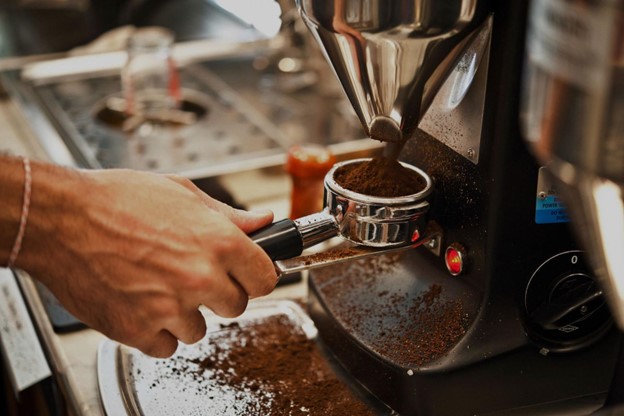Struggling with bitter or weak coffee? The issue might not be your beans—it could be your grind. This detailed guide shows you how to select the ideal coffee grinder and grind size for each brewing method. Discover the secrets to crafting café-quality coffee at home with expert-backed, simple tips. Whether you’re new to grinding or looking to fine-tune your skills, this article will help you master the art of perfect coffee every morning.
There’s nothing quite like a fresh cup of coffee. The smell, the warmth, the flavour—it’s a small moment of comfort many of us rely on. But getting that perfect cup doesn’t start with the beans. It starts with how you grind them. Understanding how to use a coffee grinder and select the right grind size is the first step to unlocking great flavour. In this guide, we’ll break it all down for you.
Table of Contents
Why the Coffee Grinder Matters
The grind is the foundation of every coffee. A poor grind can ruin even the best beans. That’s why the coffee grinder you choose and how you use it play such a critical role. When beans are ground properly, they release their full flavour during brewing. Too coarse or too fine? You’ll either get weak coffee or bitter brew. So, precision is key.
Grinding fresh also ensures maximum flavour. Pre-ground coffee loses aroma quickly. But with your coffee grinder, every cup is fresh, aromatic, and balanced.
Types of Coffee Grinders: Which One Should You Choose?
Not all grinders are made equal. Choosing the right type makes a big difference.
Blade Grinders
- Use spinning blades to chop the beans.
- Usually cheaper and compact.
- Can produce uneven grind sizes.
- Ideal for beginners or casual drinkers.
Burr Grinders
- Crush beans between two abrasive surfaces.
- Deliver consistent, even grind sizes.
- More expensive but better for quality brews.
- Perfect for espresso, pour-over, and French press lovers.
Manual Grinders
- Hand-operated, usually burr-style.
- Portable and quiet.
- Require effort but offer control and precision.
- Best for travellers or small batches.
Understanding Grind Sizes: Matching Grind to Brew Method
Different brewing methods require different grind sizes. Here’s how to get it right:
Extra Coarse Grind
- Texture: Like peppercorns.
- Best for: Cold brew.
Coarse Grind
- Texture: Like sea salt.
- Best for: French press, percolators.
Medium-Coarse Grind
- Texture: Rough sand.
- Best for: Chemex and Clever Dripper.
Medium Grind
- Texture: Like regular sand.
- Best for: Drip coffee makers, siphon brewers.
Medium-Fine Grind
- Texture: Table salt.
- Best for: Pour-over methods (like V60).
Fine Grind
- Texture: Like flour.
- Best for: Espresso machines.
Extra Fine Grind
- Texture: Powder.
- Best for: Turkish coffee.
Factors That Affect Your Grind Quality
Even with a good grinder, certain factors can still impact your results. Pay attention to the following:
Bean Type and Roast
- Darker roasts tend to be softer.
- Lighter roasts may need finer grinding for flavour.
Grinder Cleanliness
- Residue can alter taste.
- Clean your grinder weekly for best results.
Grinder Settings
- Adjust the grind size according to the method and your taste preference.
- Experimentation helps fine-tune flavour.
How to Dial in the Right Grind
Finding the best grind takes a bit of trial and error. Here’s how to approach it:
Start with the Recommended Grind
- Use the guide above to match the grind to the brew method.
Brew and Taste
- Brew your coffee and assess.
- Is it too sour? Try a finer grind.
- Too bitter? Go coarser.
Adjust in Small Steps
- Make small changes to the grind settings.
- Keep notes to track improvements.
Choosing the Right Grinder for You
When shopping for a grinder, consider:
Budget
- Blade grinders are budget-friendly but less precise.
- Burr grinders are more expensive but yield better results.
Frequency of Use
- For daily brewing, invest in a durable, reliable grinder.
- Occasional users may prefer manual or simpler options.
Brew Methods Used
- Espresso requires a very consistent grind—opt for burr.
- French press or drip can work with lower-end models.
Coffee Grinding Mistakes to Avoid
Avoid these common pitfalls:
- Grinding too early – Always grind just before brewing.
- Wrong grind size – Match the size to your brew method.
- Not cleaning the grinder – Residue can affect taste and function.
- Ignoring the roast type, adjust the grind based on the bean’s density.
- Overheating the beans – Blade grinders can cause heat that ruins flavour.
Tips for Getting the Most from Your Coffee Grinder
- Store beans in a cool, dark place to keep them fresh.
- Measure beans by weight, not volume, for consistency.
- Use a scale and timer to standardise your brewing.
- Invest in a burr grinder if you want control over your flavour.
- Taste often. Let your tongue guide your adjustments.
Why Freshly Ground Coffee Always Tastes Better
Fresh grinding releases volatile oils and aromas trapped inside beans. These fade fast after grinding. The difference in flavour between freshly ground coffee and pre-ground coffee is noticeable. It’s brighter, fuller, and more complex.
Final Thoughts
Great coffee doesn’t come by chance. It starts with a good coffee grinder and the right grind. Whether you’re a casual sipper or a serious enthusiast, getting your grind right will transform your coffee experience. With the tips shared above, you can consistently make better brews at home.

